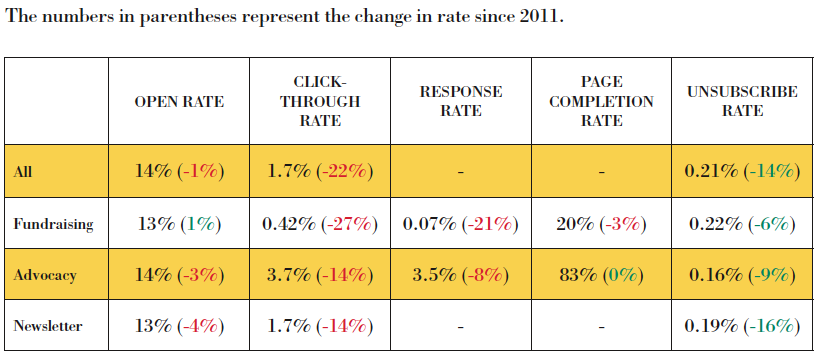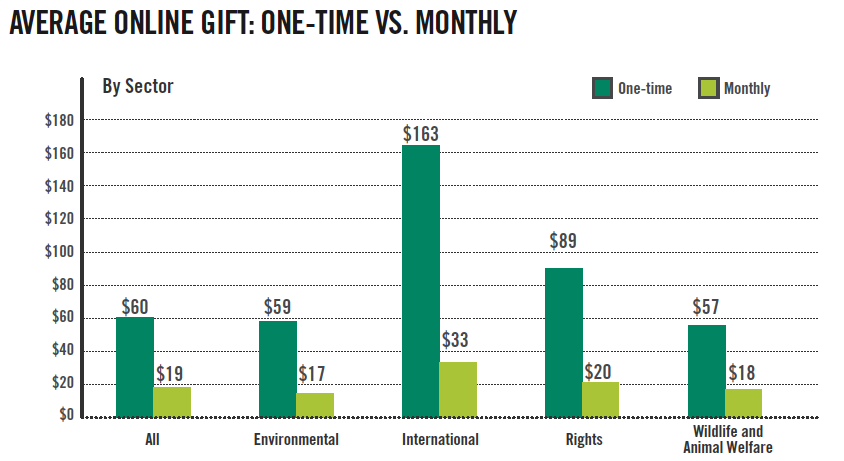 The 2013 eNonprofit Benchmarks Study with 2012 stats was just released and it's packed with all sorts of juicy email, advocacy, and fundraising data from 55 nonprofits ranging from environmental organizations to human rights organizations.
The 2013 eNonprofit Benchmarks Study with 2012 stats was just released and it's packed with all sorts of juicy email, advocacy, and fundraising data from 55 nonprofits ranging from environmental organizations to human rights organizations.
Check out the data I pulled from the report that I think is worth comparing to your own organization's benchmarks.
The good news is that online revenue is up and monthly giving programs have grown 43%. Email list sizes are continuing to grow at about 15%. Overall, nonprofits are reaching new supporters more than ever across online channels.

Now the bad news. Email response rates are down, particularly around fundraising messaging. Are nonprofits falling into the trap of treating their supporters like ATM machines? Are they not focusing on nurturing relationships with supporters and engaging them in meaningful ways? You would not believe what my email inbox looks like these days from nonprofit organizations. “Give me money” – seems to be the central theme. This is problematic because it causes list burn out and people begin to tune out and not respond to emails when you really need them.
Online Fundraising
- Increased by 21% in 2012.
- Email fundraising still accounts for 33% of overall online giving.
- Fundraising message click-through rates declined by 27% from 2011. However it’s important to note that International groups who dropped by 40%, and Rights groups who dropped by 38% skewed some of the data. However, no matter how you slice the data, click-through rates are down and that is problematic.
- Fundraising response rates are at 0.07%. This is a 21% drop from 2011.

The biggest take-away after reviewing this fundraising data is that organizations need to focus on engaging with people even if there are no major international disasters or major legislative bills to fight against. The world continues to face serious issues like the lack of affordable housing and healthcare even with the new healthcare bill passed. Climate change is happening right before our eyes. There are plenty of opportunities to engage our supporters if we do it right.
Email Messaging
- Email list size grew by 15% in 2012. Small groups grew at the fastest rate, with 35% growth far exceeding increases from 2011.
- Open rates were at 14%, similar to 2011.
- Churn Rates were at 16%.
- Advocacy email click-through rates for advocacy email messages averaged 3.7% for across sectors. Environmental groups experienced a 5.5% click-through rate for advocacy messages, nearly three times as high as the 2.1% click-through rate for International groups. Those supporters who did click through maintained relatively stable levels of page completion overall—though this did not hold true for all sectors.
- This drop in click-through rates hurt response rates. Response rates for advocacy messages stand at 3.5%. This is an 8% drop from 2011.
- Email message volume was unchanged—organizations sent an average of four messages per subscriber per month. Large groups tended to send more messages than small groups, and December was still the busiest month.
- Unsubscribe rates for individual messages were lower than in 2011 overall, and for every sector but Rights, which saw a small increase in unsubscribes per message. .21% average rate of unsubscribes.
Later this week we will dive into the social media and mobile benchmarks from the eNonprofit Benchmarks Study.



COMMENTS